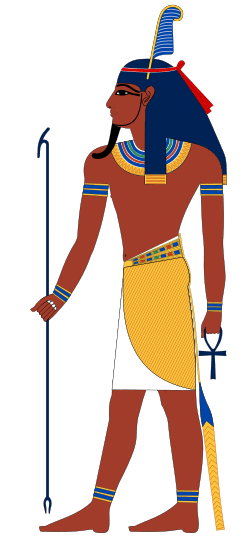Shu (god) facts for kids
Quick facts for kids Shu |
|
|---|---|

The ancient Egyptian god Shu is represented as a human with feathers on his head, as he is associated with dry and warm air. This feather serves as the hieroglyphic sign for his name. Shu could also be represented as a lion, or with a more elaborate feathered headdress.
|
|
| Major cult center | Heliopolis, Leontopolis |
| Symbol | the ostrich feather |
| Personal information | |
| Consort | Tefnut |
| Offspring | Nut and Geb |
| Parents | Ra or Atum and Iusaaset |
| Siblings | Tefnut Hathor Sekhmet Bastet |
| Greek equivalent | Atlas |
Shu was an important ancient Egyptian god. His name in Egyptian meant "emptiness" or "he who rises up." He was the husband and brother of the goddess Tefnut. Shu was part of a group of nine gods called the Ennead from the city of Heliopolis. He was known as the god of peace, lions, air, and wind.
Contents
Who is Shu?
Shu was one of the very first gods in ancient Egyptian beliefs. He was often shown as a man with a feather on his head. This feather was a symbol of his name and his connection to air. Sometimes, he was also shown as a lion or with a fancy feathered crown.
Shu's Family Tree
In the ancient Egyptian city of Heliopolis, people believed that the sun god Atum created the first two gods, Shu and Tefnut. They were the first couple of the Ennead, a group of nine important gods.
Shu and Tefnut had two children:
Shu was also the grandfather of four famous gods and goddesses:
His great-grandsons were Horus and Anubis.
What are Shu's Powers and Roles?
Shu had several important roles in Egyptian mythology:
God of Air and Wind
Shu was the god of air and wind. The ancient Egyptians believed he was the cool, calm air that existed between the earth and the sky. He was thought to bring peace and order, much like a gentle breeze.
His symbols included:
- The ostrich feather: This feather was a sign of how light and empty the air is.
- Fog and clouds: These were sometimes called Shu's "bones."
Separator of Sky and Earth
One of Shu's most important jobs was to separate the sky from the earth. In Egyptian myths, the sky goddess Nut and the earth god Geb were once joined together. Shu lifted Nut into the sky, creating space for life to exist on Earth. Without Shu holding them apart, the Egyptians believed there would be no room for people or animals to live.
A Story of Tefnut's Journey
There is a myth about Shu and Tefnut having an argument. Tefnut left Egypt and went to Nubia, a warmer land. Shu missed her very much. However, Tefnut had turned into a fierce cat that attacked anyone who came near her. The god Thoth eventually managed to convince her to return to Egypt. This story might have been a way to explain bad weather or droughts in ancient times.
How was Shu Depicted?
Shu was usually shown as a man. He often carried an ankh, which is the ancient Egyptian symbol of life. When he was shown as a protector or fighter for the sun god, he sometimes had the head of a lion.
Shu and Atlas
The ancient Greeks saw similarities between Shu and their own god, Atlas. Atlas was a Titan who held up the sky. Both Shu and Atlas were depicted holding up the sky, which is why the Greeks connected them.
See also
 In Spanish: Shu (mitología) para niños
In Spanish: Shu (mitología) para niños


